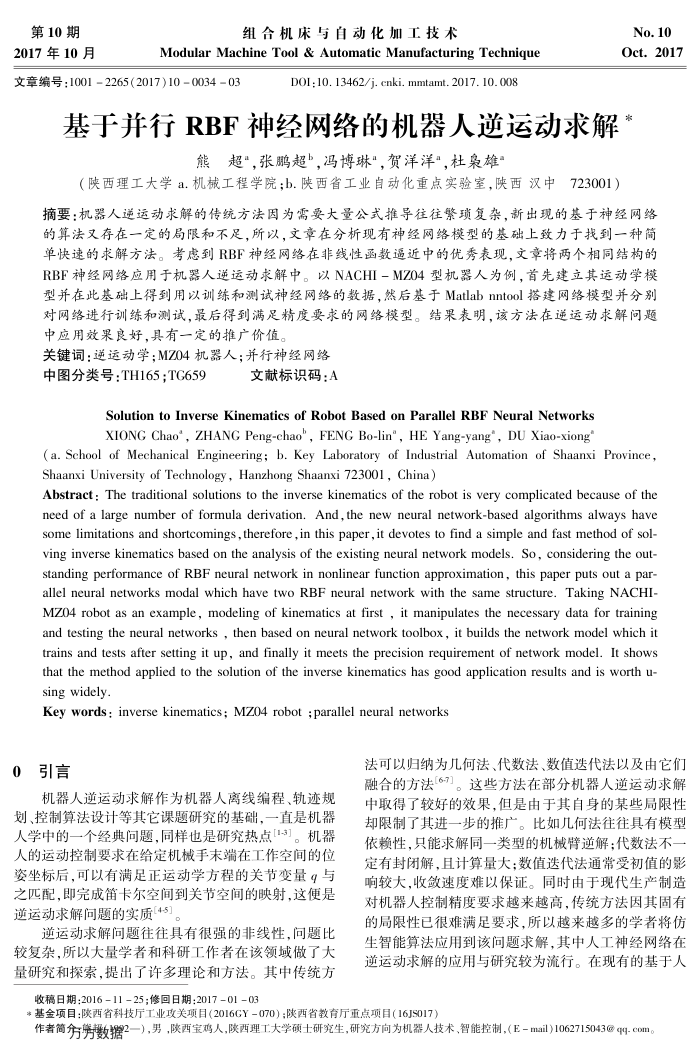您当前的位置:首页>论文资料>基于并行RBF神经网络的机器人逆运动求解
内容简介
 第10期 2017年10月
第10期 2017年10月组合机床与自动化加工技术
Modular Machine Tool & Automatic Manufacturing Technique
文章编号:10012265(2017)10003403
D01:10.13462/j.cnki.mmtamt.2017.10.008
No.10 Oct.2017
基于并行RBF神经网络的机器人逆运动求解
熊超",张鹏超”,冯博琳”,贺洋洋“,杜枭雄”
(陕西理工大学a.机械工程学院:b.陕西省工业自动化重点实验室,陕西汉中723001)
摘要:机器人逆运动求解的传统方法因为需要大量公式推导往往繁项复杂,新出现的基于神经网络的算法文存在一定的局限和不足,所以,文章在分析现有神经网络模型的基础上致力于找到一种简单快速的求解方法。考虑到RBF神经网络在非线性函数逼近中的优秀表现,文章将两个相同结构的 RBF神经网络应用于机器人逆运动求解中。以NACHI-MZ04型机器人为例,首先建立其运动学模型并在此基础上得到用以训练和测试神经网络的数据,然后基于Matlabnntool搭建网络模型并分别对网络进行训练和测试,最后得到满足精度要求的网络模型。结果表明,该方法在逆运动求解问题中应用效果良好,具有一定的推广价值。
关键词:逆运动学:MZ04机器人;并行神经网络
中图分类号:TH165;TG659
文献标识码:A
Solution to Inverse Kinematics of Robot Based on Parallel RBF Neural Networks XIONG Chao", ZHANG Peng-chao', FENG Bo-lin", HE Yang-yang', DU Xiao-xiong
(a. School of Mechanical Engineering; b. Key Laboratory of Industrial Automation of Shaanxi Province, Shaanxi University of Technology, Hanzhong Shaanxi 723001, China)
Abstract : The traditional solutions to the inverse kinematics of the robot is very complicated because of thc need of a large number of formula derivation.And,the new neural network-based algorithms always have some limitations and shortcomings,therefore,in this paper,it devotes to find a simple and fast method of sol-ving inverse kinematics based on the analysis of the existing neural network models. So, considering the out-standing performance of RBF neural network in nonlinear function approximation, this paper puts out a par allel neural networks modal which have two RBF neural network with the same structure. Taking NACHI-MZ04 robot as an example, modeling of kinematics at first , it manipulates the necessary data for training and testing the neural networks, then based on neural network toolbox,it builds the network model which it trains and tests after setting it up, and finally it meets the precision requirement of network model. It shows that the method applied to the solution of the inverse kinematics has good application results and is worth u-singwidely
Key words: inverse kinematics; MZo4 robot ;parallel neural networks
0引言
机器人逆运动求解作为机器人离线编程、轨迹规划、控制算法设计等其它课题研究的基础,一直是机器人学中的一个经典问题,同样也是研究热点[1-3]。机器人的运动控制要求在给定机械手未端在工作空间的位姿坐标后,可以有满足正运动学方程的关节变量9与之匹配,即完成笛卡尔空间到关节空间的映射,这便是逆运动求解问题的实质[45]。
逆运动求解问题往往具有很强的非线性,问题比较复杂,所以大量学者和科研工作者在该领域做了大量研究和探索,提出了许多理论和方法。其中传统方
法可以归纳为几何法、代数法、数值迭代法以及由它们融合的方法[6-]。这些方法在部分机器人逆运动求解中取得了较好的效果,但是由于其自身的某些局限性却限制广其进一步的推产。比如几何法往往具有模型依赖性,只能求解同一类型的机械臂逆解;代数法不一定有封闭解,且计算量大;数值迭代法通常受初值的影响较大,收敛速度难以保证。同时由于现代生产制造对机器人控制精度要求越来越高,传统方法因其固有的局限性已很难满足要求,所以越来越多的学者将伤生智能算法应用到该问题求解,其中人工神经网络在逆运动求解的应用与研究较为流行。在现有的基于人
收稿日期:2016-11-25;修回日期:201701-03
*基金项目:陕西省科技厅工业攻关项目(2016GY-070);陕西省教育厅重点项目(16JS017)
作者简分势数播2一),男,陕西宝鸡人,陕西理工大学硕士研究生,研究方向为机器人技术、智能控制,(E-mail)1062715043@q-com。